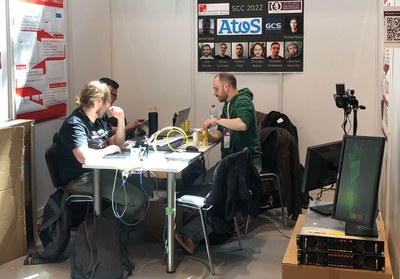07.06.2022
The top position is taken by the US supercomputer Frontier at Oak Ridge National Laboratory (ORNL) with 1.1 exaflops in the Linpack benchmark. While it is considered certain that China has been operating at least two exascale systems for some time with the Sunway TaihuLight 2 and Tianhe-3 systems, neither of these have been reported for the TOP500.
The number of German systems on the list has increased from 26 to 31. As in the previous year, the three large centers of the Gauss Centre for Supercomputers dominate the list. The DKRZ computer Levante joins the list as the eighth most powerful German system. During ISC'22, interested participants had the opportunity to take a personal look at it during two guided tours.
Impressions: DKRZ@ISC'22
Under the motto #TransformingTheFuture, the ISC'22 conference offered the 3000 participants an opportunity for international exchange on the most important developments in the fields of HPC, machine learning and data analysis. In the parallel exhibition, 137 companies and institutions presented their work and products.
The DKRZ booth was as part of the German HPC Village, where the centers of the Gauss Alliance, the NHR Association and other national HPC stakeholders presented their work in neighbouring booths.
During the Birds of a Feather session "LUSTRE in HPC, AI and Big Data: Widening Scope, New Features and Roadmap" on May 31, developers, administrators and users discussed the a roadmap, the current state, new features, innovative developments and implementations, and new challenges. Among the speakers Carsten Beyer on the behalf of Prof. Thomas Ludwig, talked about the experiences with lustre at DKRZ.

Left: At the Gauss Alliance booth on May 30, Dr. Panagiotis Adamidis presented efforts to adapt the ICON climate model for exascale computers with heterogeneous architecture of CPUs/GPUs, which requires reprogramming the ICON software to a scalable, modularized and flexible code. Right: At its booth, DKRZ provided information about its new supercomputer Levante and showed high-resolution global climate visualizations on a climate globe and an interactive touch table.

Left: Visitor magnets at the DKRZ booth were the storm-resolving global climate visualizations modeled within the Center of Excellence ESiWACE and presented on the climate globe during ISC. Center: Interested visitors took the opportunity to attend a guided tour to the new HPC system "Levante" at DKRZ. Right: After a two-year break, the ISC High Performance 2022 took place again in person at the CCH in Hamburg from May 29 to June 2, 2022.

17 international teams participated in this year's Student Cluster Competition (SCC), amaong them the joint Team Elbe of the Universities of Hamburg and Magdeburg with the support of the two tutors Jannek Squar and Anna Fuchs, Scientific Computing Group at DKRZ. The highly motivated and competent team attracted positive attention from the judges by modifying the hardware in order to solve technical problems, even though it finally did not achieve one of the top ranks at the SCC. The cooperation between the two universities has proven its worth and will be continued in the coming year.
DKRZ put together an ICON application for the Student Cluster Competition as one of the tasks and was represented on its jury committee by Dr. Panagiotis Adamidis.
